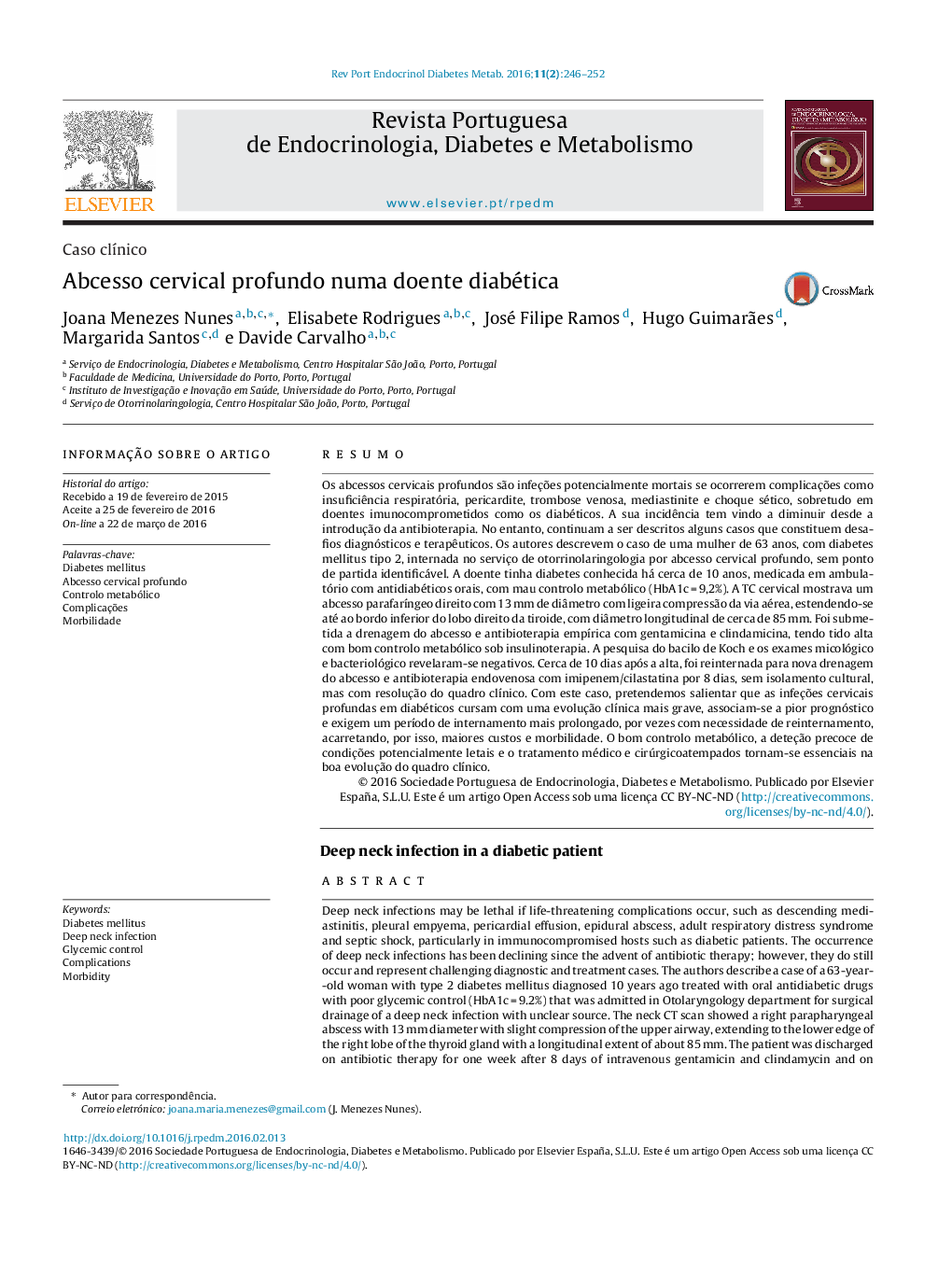| کد مقاله | کد نشریه | سال انتشار | مقاله انگلیسی | نسخه تمام متن |
|---|---|---|---|---|
| 3278207 | 1589722 | 2016 | 7 صفحه PDF | دانلود رایگان |

ResumoOs abcessos cervicais profundos são infeções potencialmente mortais se ocorrerem complicações como insuficiência respiratória, pericardite, trombose venosa, mediastinite e choque sético, sobretudo em doentes imunocomprometidos como os diabéticos. A sua incidência tem vindo a diminuir desde a introdução da antibioterapia. No entanto, continuam a ser descritos alguns casos que constituem desafios diagnósticos e terapêuticos. Os autores descrevem o caso de uma mulher de 63 anos, com diabetes mellitus tipo 2, internada no serviço de otorrinolaringologia por abcesso cervical profundo, sem ponto de partida identificável. A doente tinha diabetes conhecida há cerca de 10 anos, medicada em ambulatório com antidiabéticos orais, com mau controlo metabólico (HbA1c = 9,2%). A TC cervical mostrava um abcesso parafaríngeo direito com 13 mm de diâmetro com ligeira compressão da via aérea, estendendo‐se até ao bordo inferior do lobo direito da tiroide, com diâmetro longitudinal de cerca de 85 mm. Foi submetida a drenagem do abcesso e antibioterapia empírica com gentamicina e clindamicina, tendo tido alta com bom controlo metabólico sob insulinoterapia. A pesquisa do bacilo de Koch e os exames micológico e bacteriológico revelaram‐se negativos. Cerca de 10 dias após a alta, foi reinternada para nova drenagem do abcesso e antibioterapia endovenosa com imipenem/cilastatina por 8 dias, sem isolamento cultural, mas com resolução do quadro clínico. Com este caso, pretendemos salientar que as infeções cervicais profundas em diabéticos cursam com uma evolução clínica mais grave, associam‐se a pior prognóstico e exigem um período de internamento mais prolongado, por vezes com necessidade de reinternamento, acarretando, por isso, maiores custos e morbilidade. O bom controlo metabólico, a deteção precoce de condições potencialmente letais e o tratamento médico e cirúrgicoatempados tornam‐se essenciais na boa evolução do quadro clínico.
Deep neck infections may be lethal if life‐threatening complications occur, such as descending mediastinitis, pleural empyema, pericardial effusion, epidural abscess, adult respiratory distress syndrome and septic shock, particularly in immunocompromised hosts such as diabetic patients. The occurrence of deep neck infections has been declining since the advent of antibiotic therapy; however, they do still occur and represent challenging diagnostic and treatment cases. The authors describe a case of a 63‐year‐old woman with type 2 diabetes mellitus diagnosed 10 years ago treated with oral antidiabetic drugs with poor glycemic control (HbA1c = 9.2%) that was admitted in Otolaryngology department for surgical drainage of a deep neck infection with unclear source. The neck CT scan showed a right parapharyngeal abscess with 13 mm diameter with slight compression of the upper airway, extending to the lower edge of the right lobe of the thyroid gland with a longitudinal extent of about 85 mm. The patient was discharged on antibiotic therapy for one week after 8 days of intravenous gentamicin and clindamycin and on insulin therapy with good glycemic control. The results of microbiologic culture of the purulent collection from surgery were negative as well as Koch Bacillus test. Ten days after discharge she was re‐admitted for surgical drainage of the same abscess. She presented a good clinical course and cultures were negative once more. With this case report we want to point out that the clinical course of deep neck infections in diabetic patients is more severe, carries out a worst prognosis and requires a longer stay in hospital, sometimes with need for re‐admittance and leading to higher costs and morbidity. The combination of appropriate intravenous antibiotic therapy, surgical drainage, securing of airway and good metabolic control are recognized cornerstones of the treatment.
Journal: Revista Portuguesa de Endocrinologia, Diabetes e Metabolismo - Volume 11, Issue 2, July–December 2016, Pages 246–252